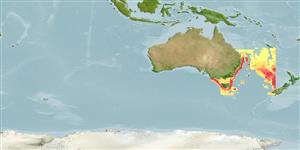Classification / Names
Common names from other countries
Main reference
Size / Weight / Age
Max length : 130 cm TL male/unsexed; (Ref. 40637); 106.5 cm TL (female); common length : 45.0 cm TL male/unsexed; (Ref. 9258); common length :65 cm TL (female); max. published weight: 7.5 kg (Ref. 40637); max. reported age: 32 years (Ref. 6390)
Environment
Marine; freshwater; brackish; benthopelagic; catadromous (Ref. 9258); depth range 0 - 3000 m (Ref. 86942)
Climate / Range
Subtropical, preferred ?; 18°S - 47°S, 140°E - 168°E
Distribution
Southwest Pacific: east coast of Australia and New Zealand, extending north to New Caledonia. Museum records from Fiji and Tahiti are doubtful. Australian and New Zealand forms sometimes recognized as subspecies. Most easily confused with Anguilla obscura and the surest way of distinguishing them is to count the vertebrae. Reported from Western and American Samoa (Ref. 592).
Countries | FAO areas | Ecosystems | Occurrences | Introductions
IUCN Red List Status (Ref. 115185)
Threat to humans
Harmless
Human uses
Fisheries: commercial; aquaculture: commercial; gamefish: yes
More information
ReferencesAquacultureAquaculture profileStrainsGeneticsAllele frequenciesHeritabilityDiseasesProcessingMass conversion
Tools
Special reports
Download XML
Internet sources
Estimates of some properties based on models
Phylogenetic diversity index
PD50 = 0.5000 many relatives (e.g. carps) 0.5 - 2.0 few relatives (e.g. lungfishes)
Trophic Level
4.3 ±0.5 se; Based on diet studies.
Resilience
Low, minimum population doubling time 4.5 - 14 years (tm=8-30; Fec=3,000,000)
Vulnerability
Very high vulnerability (78 of 100)
Price category
